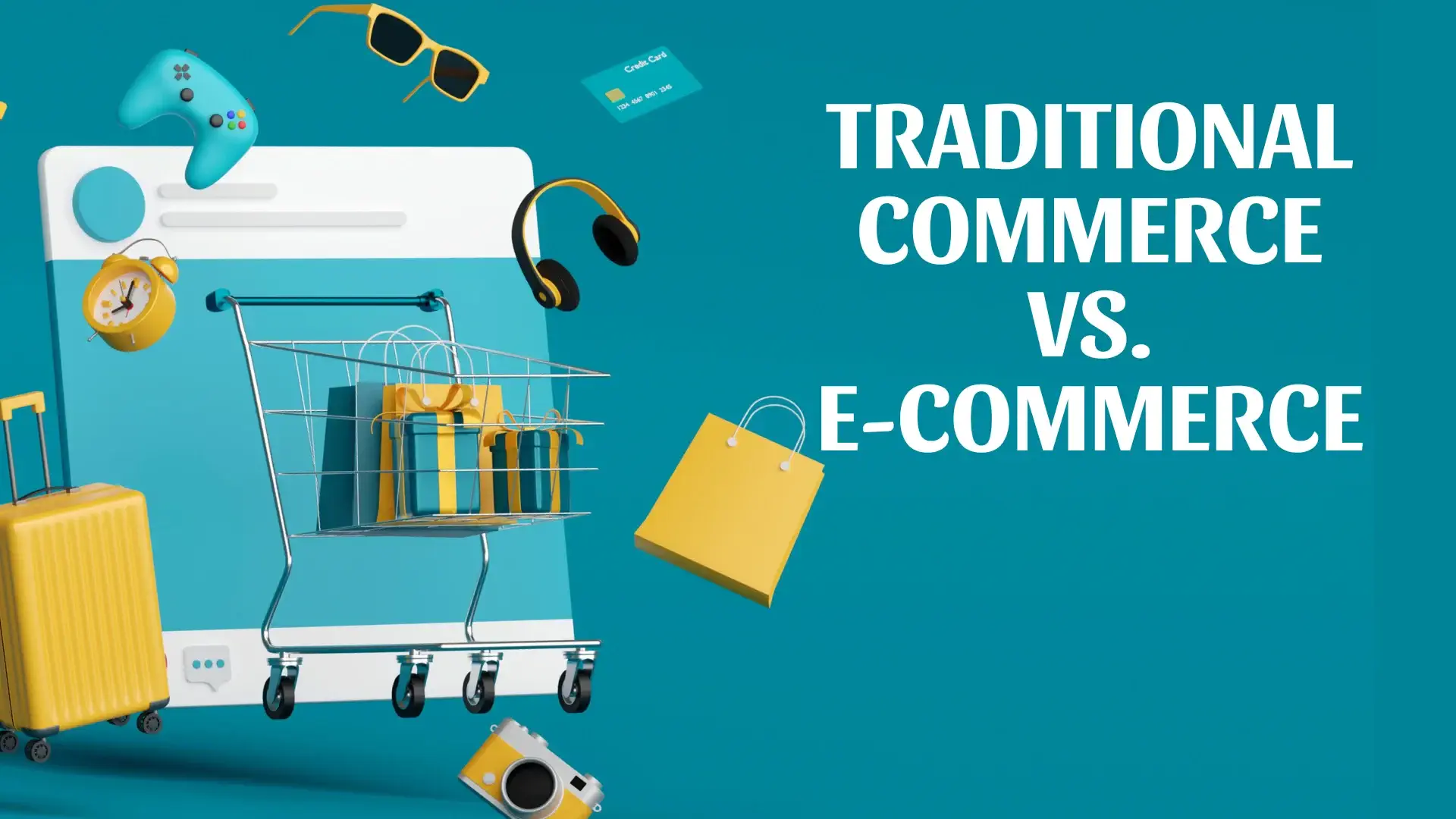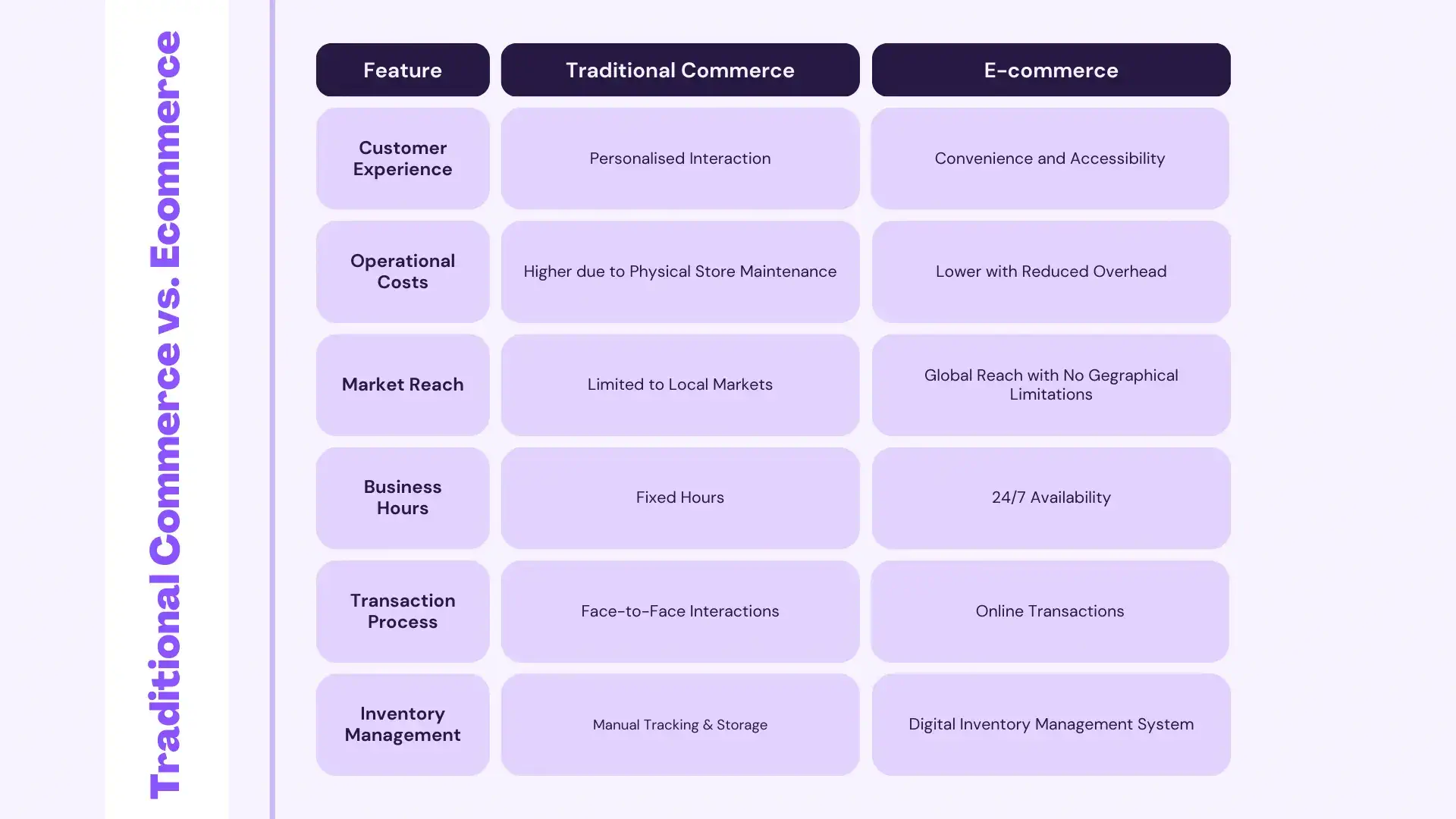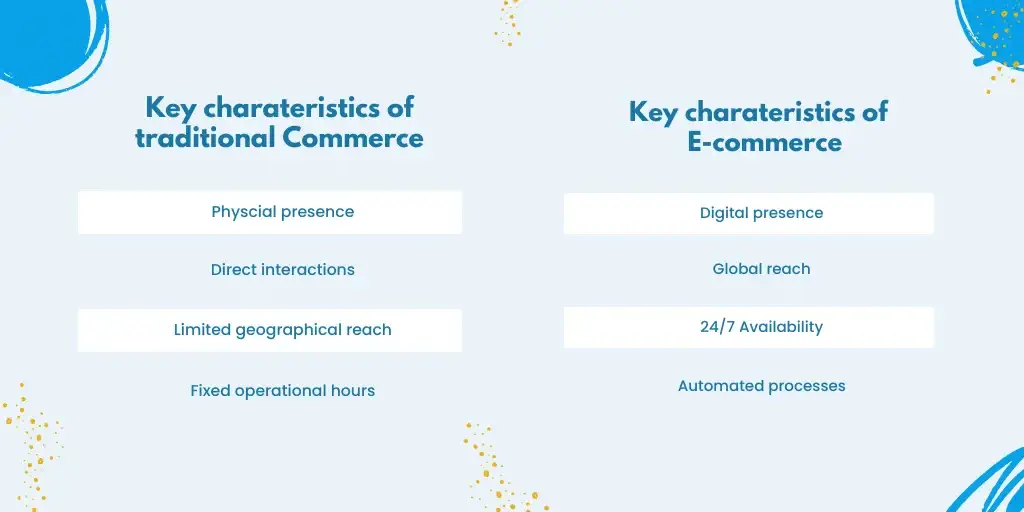In the digital age, businesses are navigating a vast landscape where the lines between physical and virtual storefronts are blurring. The age-old question of traditional commerce vs. ecommerce remains a critical decision for entrepreneurs and established businesses.
Today, in this comprehensive guide, we will bridge the divide by exploring both approaches’ key differences, advantages, and disadvantages.
What is Traditional Commerce?
Traditional commerce refers to the exchange of goods and services through physical retail stores or face-to-face interactions. It involves direct human interaction and tangible transactions.
Here are some main characteristics of Traditional Ecommerce:
- Physical Presence:Requires a brick-and-mortar location, creating a tangible customer experience.
- Direct Interaction:Allows face-to-face interactions between customer and seller, fostering personalised service.
- Limited Geographical Reach:Customers are restricted to the store’s location, limiting the potential market size.
- Fixed Operational Hours:Bound by opening and closing times, potentially hindering customer convenience.
Advantages of Traditional Commerce
- Personalised Customer Service:Allows for direct interaction and building rapport with customers.
- Immediate Gratification:Customers can receive products immediately after purchase, satisfying the desire for instant ownership.
- Building Trust:A physical presence can establish trust and credibility for your brand.
Disadvantages of Traditional Commerce
- High Overhead Costs:Rent, utilities, and staffing can be significant financial burdens.
- Limited Market Reach:Geographic constraints restrict customer base and growth potential.
- Operational Limitations:Fixed business hours can limit customer accessibility.
What is Ecommerce?
Ecommerce, or electronic commerce, refers to buying and selling goods and services online. It leverages digital platforms to conduct transactions and offers a variety of online payment methods.
Some key characteristics of Ecommerce:
- Digital Presence:Operates through websites and mobile applications, providing accessibility from anywhere with an internet connection.
- Global Reach:The potential to reach customers worldwide, significantly expanding your market.
- 24/7 Availability:Provides continuous service, allowing customers to shop conveniently.
- Automated Processes:Utilises technology to streamline operations, reduce labour costs, and increase efficiency.
Advantages of Ecommerce
- Wider Market Reach:Can attract customers from a global audience, boosting sales potential.
- Cost-Effective:Lower operational costs than physical stores, allowing flexible pricing strategies.
- Convenience:Enables customers to shop anytime, anywhere, catering to busy lifestyles.
- Data Insights:Provides valuable customer data and analytics for better decision-making, targeted marketing, and product development.
Disadvantages of Ecommerce
- Security Concerns:Risks of cyber-attacks and data breaches require robust security measures.
- Lack of Physical Interaction:Limited personal customer service can hinder building rapport with customers.
- Delivery Delays: Customers are waiting for shipping, potentially leading to frustration.
Traditional Commerce vs. Ecommerce
Future Trends in Commerce
The future of commerce is likely to be a hybrid model that merges the strengths of both traditional and ecommerce. Here are some emerging trends to consider:
- Experiential Retail:Traditional stores are evolving to offer interactive and immersive experiences, drawing customers in and fostering brand loyalty.
- Omni-Channel Integration:Seamlessly connecting online and offline channels provides a unified customer experience, regardless of where they shop.
- AI and Automation:Ecommerce will leverage artificial intelligence for personalised shopping experiences and automated customer service.
- Augmented Reality (AR):AR will allow customers to virtually try on products or see how they would look in their homes, enhancing the online shopping experience. According to ScienceSoft, the global market of Augmented Reality for retail was estimated at $3.8 billion in 2021 and is projected to reach $17.86 billion by 2028.
- Blockchain Technology: According to Practical Ecommerce, Blockchain technology offers much potential for commerce business. It Enhances security and transparency in transactions.
FAQ on the Difference between Traditional Commerce and Ecommerce
What is the difference between traditional commerce and ecommerce?
The difference between traditional commerce and ecommerce lies in their business methods. Traditional commerce involves physical transactions conducted in brick-and-mortar stores, while ecommerce refers to the online buying and selling of goods and services over the internet.
Can a business integrate both traditional commerce and ecommerce?
Yes, businesses can integrate both approaches to leverage their strengths. This omnichannel strategy can enhance customer satisfaction and expand market reach.
How can I improve my ecommerce website’s SEO?
To improve your ecommerce website’s SEO, focus on using targeted keywords, creating quality content, optimising your site for mobile devices, and ensuring fast loading times.
What are some key strategies for success in ecommerce?
Successful ecommerce strategies include:
- SEO optimisation.
- Social media marketing.
- User-friendly website design.
- Utilising data analytics to understand customer behaviour.
Can you provide an example to differentiate between traditional commerce and ecommerce?
In traditional commerce, an example would be purchasing groceries at a local supermarket, where customers physically visit the store, select items from shelves, and make purchases at the checkout counter. In contrast, ecommerce involves buying clothing online from an ecommerce website, where customers browse through product listings, add items to their virtual cart, and complete the purchase through digital online transactions.
Conclusion
Both traditional commerce and ecommerce have their unique strengths and challenges. While traditional commerce offers personal interaction and immediate product access, ecommerce provides convenience, a broader reach, and cost savings. Businesses must evaluate their goals and resources to determine the most suitable approach or consider integrating both to maximise their potential.
By understanding these differences and implementing effective strategies, businesses can thrive in the competitive market. Whether you choose the personal touch of traditional commerce or the vast opportunities of e-commerce, the key lies in delivering value and satisfaction to your customers.
JustSell Wholesale Ecommerce simplifies the process by providing a comprehensive platform designed explicitly for wholesalers. Cost-effective compared to other options, JustSell empowers you to establish a robust online presence with built-in features for social media management and email marketing campaigns. The platform’s user-friendly design ensures a smooth experience for vendors and customers. Whether you’re a seasoned wholesaler looking to streamline your online operations or have just started, JustSell Wholesale Ecommerce equips you with the tools and resources to thrive in the ecommerce landscape.
See how JustSell Wholesale Ecommerce can help your business by scheduling a demo today to see it in action!




